Difference between revisions of "Clematis texensis"
Proc. Acad. Nat. Sci. Philadelphia 13: 448. 1862.
FNA>Volume Importer |
FNA>Volume Importer |
(No difference)
| |
Revision as of 22:12, 16 December 2019
Stems viny, to 3 m, glabrous or sometimes ± hirsute near nodes. Leaf blade 1-pinnate; leaflets 6-10 plus additional tendril-like terminal leaflet, ovate to nearly round, unlobed, 2-3-lobed, or most proximal occasionally 3-foliolate, 1-9 × 1-6 cm, leathery, ± prominently reticulate adaxially; surfaces abaxially usually glabrous, occasionally sparsely pubescent, glaucous. Inflorescences axillary, 1-7-flowered. Flowers ovoid to urn-shaped; sepals rose-red to scarlet abaxially and at tip adaxially, ovate-lanceolate, 1.5-3 cm, margins not expanded, thick, not crispate, tomentose, tips acute to acuminate, recurved, abaxially glabrous. Achenes: bodies appressed-pubescent; beak 4-7 cm, plumose. 2n = 16.
Phenology: Flowering spring–summer (Mar–Jun).
Habitat: Woodlands, calcareous cliffs, and stream banks
Elevation: 80-700 m
Discussion
Although widely cultivated because it is the only species of Clematis with truly red flowers, C.texensis is native only to the southeastern part of the Edwards Plateau, Texas.
Selected References
None.
